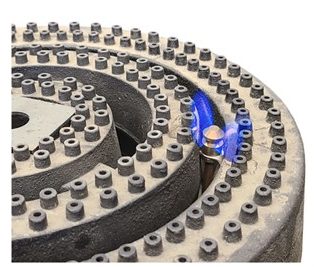Learning Task 1
Describe Pilot Ignition Systems
The primary function of a pilot burner is to ignite the main burner flame. Most pilot burners may also serve as a component in the flame safety circuit. As long as the pilot flame is present then the main burner should ignite smoothly therefore the pilot is monitored by a device that will shut of the gas supply to the main burner if the pilot flame is extinguished.

Pilot Type (Ignition Sequence)
The common types of pilot ignition sequences are: continuous, intermittent and interrupted.
Continuous Pilot
Also known as a “standing pilot”, continuous pilots burn continuously regardless of whether the main burner is firing or not. The continuous flame is needed, as the pilot flame is typically also being used on a heat activated safety device such as a thermocouple. These were often used on residential storage-type hot water tanks and fireplaces but are being phased as the continuous use of fuel decreases the efficiency of the appliance.
Intermittent Pilot
Unlike the continuous pilot, the intermittent pilot is present only during the operation of the main burner, the pilot is ignited by an electronic spark or hot surface igniter when there is a call for heat. Once the pilot is ignited and proven by a flame safeguard device, the control module will allow gas to flow to the main burner for ignition by the pilot flame. The pilot remains lit, and monitored, throughout the main burner cycle and when the call for heat is satisfied, the pilot and main burners are shut off. For efficiency reasons intermittent pilot systems are replacing most previous standing pilot applications.
Interrupted Pilot
These are similar to intermittent pilots, except that the pilot flame extinguishes when the main burner has been ignited. Rather than monitor the pilot flame the flame safeguard will monitored the main burner during its operation until the call for heat is satisfied and then the main burner is extinguished. This system is not common on residential appliances and only used on larger commercial and industrial applications with programable burner management systems.
 Now complete Self-Test 1 and check your answers.
Now complete Self-Test 1 and check your answers.
Self-Test 1
Self-Test 1
- What are the three common of pilot ignition systems?
- Direct spark, Hot surface, Intermittent
- Intermittent, Interrupted, Piezo
- Continuous pilot, Thermocouple, Fame rod
- Continuous, Intermittent, Interrupted
- For which of the pilot ignition systems is the pilot flame typically also being used on a heat activated safety device such as a thermocouple?
- Auto Pilot
- Interrupted pilot
- Continuous pilot
- Intermittent Pilot
- For which of the pilot ignition systems does the pilot flame remain lit throughout the main burner cycle and when the call for heat is satisfied, the pilot and main burners are shut off?
- Auto Pilot
- Interrupted pilot
- Continuous pilot
- Intermittent Pilot
- For which of the pilot ignition systems is the pilot flame extinguished when the main burner has been ignited?
- Auto Pilot
- Interrupted pilot
- Continuous pilot
- Intermittent Pilot
Check your answers using the Self-Test Answer Keys in Appendix 1.
Media Attributions
- Figure 1 “Pilot flame” by Camosun College is licensed under a CC BY 4.0 licence.

